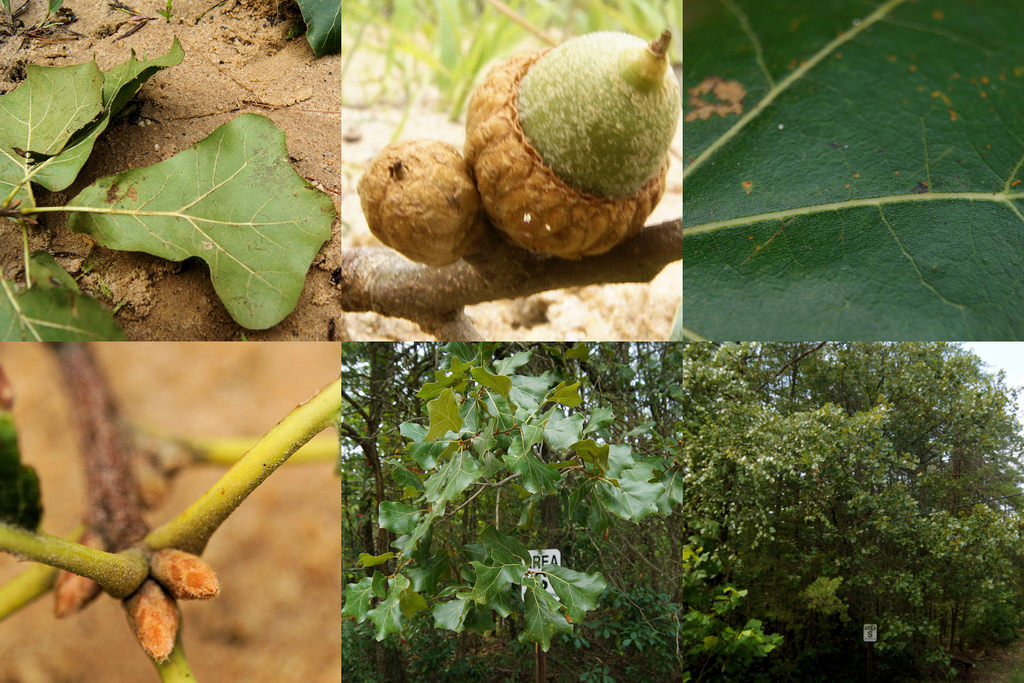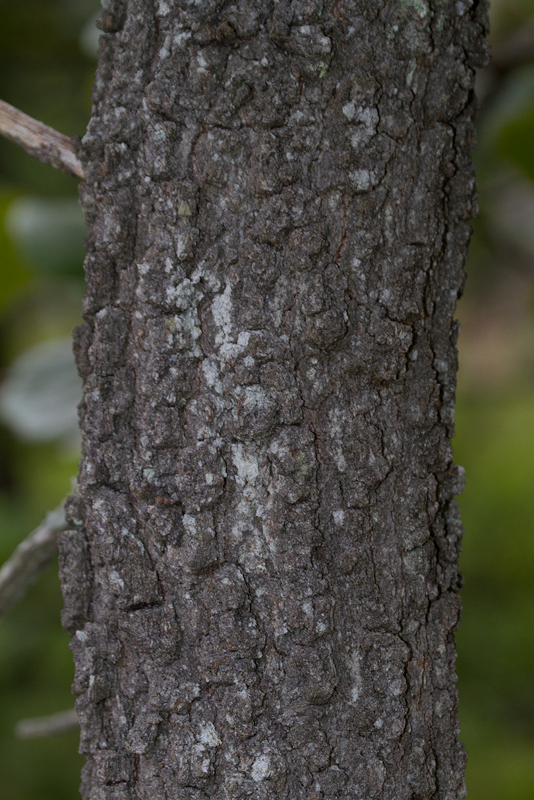Map Snapshot
















167 Records
Status
Grows in dry, sandy, or shaly soils, of the Coastal Plain and Piedmont; frequent on serpentine barrens (Brown and Brown, 1972).
Distributed from Iowa east to New Jersey and Long Island, New York, south to Florida, west to Texas, and north to Nebraska. Blackjack Oak is considered a pioneer species (Stein, et al., 2003).
Description
Blackjack Oak belongs to the Red Oak group. A small or medium-sized tree, slow-growing and short-lived. Leaves have 3 to 5 broad lobes above the middle and are narrow at base.
Where To Find
Blackjack Oak can be easily observed along the trails at Soldier's Delight in Baltimore County.
Seasonality Snapshot
Source: Wikipedia
| Blackjack oak | |
|---|---|

| |
| Dormant blackjack in the Cross Timbers of Lincoln County, Oklahoma | |
| Scientific classification | |
| Kingdom: | Plantae |
| Clade: | Tracheophytes |
| Clade: | Angiosperms |
| Clade: | Eudicots |
| Clade: | Rosids |
| Order: | Fagales |
| Family: | Fagaceae |
| Genus: | Quercus |
| Subgenus: | Quercus subg. Quercus |
| Section: | Quercus sect. Lobatae |
| Species: | Q. marilandica
|
| Binomial name | |
| Quercus marilandica | |

| |
| Generalized natural range of Quercus marilandica | |
| Synonyms[4][5] | |
| |
Quercus marilandica, the blackjack oak, is a small oak, one of the red oak group Quercus sect. Lobatae. It is native to the eastern and central United States.
Description
[edit]Quercus marilandica is a small deciduous tree growing to 15 meters (49 feet) tall, with bark cracked into rectangular black plates with narrow orange fissures. The leaves are 7–20 centimeters (3–8 inches) long and broad, and typically flare from a tapered base to a broad three-lobed bell shape with only shallow indentations. They are dark green and glossy above, pubescent underneath, and often remain attached to the twigs through the winter after turning colors from red to brown in the fall. The acorn is small, 12–20 millimeters (1⁄2–3⁄4 in) long and 10–18 mm (3⁄8–3⁄4 in) broad; like those of other red oaks, it takes 18 months to mature.[6]
Blackjack oaks in the Cross Timbers can grow from 15 to 18 m (50 to 60 ft) high but seldom reach more than 12 m (40 ft), with a trunk diameter of 41 cm (16 in). The leaves are from 10 to 25 cm (4 to 10 in) in length and about the same width.
Distribution and habitat
[edit]The blackjack oak can be found from Long Island in New York to Florida, west as far as Texas, Oklahoma, and Nebraska. There are reports of a few isolated populations in southern Michigan, but these appear to represent introductions.[7][8]
The species grows in poor, thin, dry, rocky or sandy soils where few other woody plants can thrive, usually on low ground, from sea level up to approximately 850 m (2,800 ft) in altitude. Some sources say that it does not have the beautiful form of many oaks, but is nonetheless a valuable tree for growing in problem sites.[9] Some say that the tree is "tough but ugly", but also underappreciated.[10][11] At times the tree has even been actively eradicated to provide room for trees deemed to be more commercially valuable.[12]
It is sometimes an understory tree in pine stands on sandy knolls in the southeastern US. Along the coastal plain of New Jersey the probability of finding this species is increased in relatively sunny, open areas such as those near coastal salt marshes. It often occurs near scarlet and post oaks as well as pitch pine; understory companions include winged sumac, bracken, sweetfern, and bayberry, and can be found as far north as parts of Ohio[13] and New York.
A variety, Quercus marilandica Münchhausen var. ashei Sudworth,[6] grows in the western portions of its range – northern Texas, Oklahoma, and into southern Kansas. In this area, blackjack and post oak form a semi-savanna area composed of forested strips intermixed with prairie grass glades along the eastern edge of the southern Great Plains. This semi-savanna is known as the Cross Timbers.[14][15][16] Scrub forms of Q. marilandica dominate on many chert glades along with Q. stellata in Arkansas's Ozark plateau.[17]
Ecology
[edit]Blackjack oak sometimes hybridizes with bear oak (Q. ilicifolia), forming a hybrid known as Q. × brittonii.[18]
Blackjack acorns provide food for both whitetail deer and wild turkey. Blackjacks may, however, cause tannic acid poisoning in cattle.
Uses
[edit]The wood is very dense and produces a hot flame when burned, which functions as an excellent source of heat for barbecues and wood-burning stoves. However, the wood is not desirable for wood fireplaces because the heat causes popping, thereby increasing the risk of house fires.[19]
Traditionally blackjack wood is used as both a fuel and smoke wood for barbecue in Oklahoma.
References
[edit]- ^ Wenzell, K.; Kenny, L. (2015). "Quercus marilandica". IUCN Red List of Threatened Species. 2015: e.T194195A2303635. doi:10.2305/IUCN.UK.2015-4.RLTS.T194195A2303635.en. Retrieved 12 November 2021.
- ^ "NatureServe Explorer 2.0".
- ^ Münchhausen, Otto von (1770). "Verzeichniß der Bäume und Stauden, welche in Deutschland fortkommen". Der Hausvater. Vol. 5. Hannover: Försters und Sohns Erben. pp. 253: diagnosis in Latin, description in German in Teutonic script.
{{cite book}}: CS1 maint: postscript (link) - ^ "Quercus marilandica (L.) Münchh". World Checklist of Selected Plant Families. Royal Botanic Gardens, Kew. Retrieved 31 October 2017 – via The Plant List. Note that this website has been superseded by World Flora Online
- ^ "Quercus marilandica Münchh". Tropicos. Missouri Botanical Garden. Retrieved 31 October 2017.
- ^ a b Nixon, Kevin C. (1997). "Quercus marilandica". In Flora of North America Editorial Committee (ed.). Flora of North America North of Mexico (FNA). Vol. 3. New York and Oxford: Oxford University Press. Retrieved 31 October 2017 – via eFloras.org, Missouri Botanical Garden, St. Louis, MO & Harvard University Herbaria, Cambridge, MA.
- ^ "Quercus marilandica Range Map" (PDF). United States Geological Survey. Archived from the original (PDF) on 16 July 2011. Retrieved 2008-03-05.
- ^ "Quercus marilandica". County-level distribution map from the North American Plant Atlas (NAPA). Biota of North America Program (BONAP). 2014. Retrieved 31 October 2017.
- ^ Liming, Franklin G. (1 March 1942). "Blackjack Oak in the Missouri Ozarks". Journal of Forestry. 40 (3). Society of American Foresters: 249–252.
- ^ Klingaman, Gerald (September 22, 2000). "Plant of the Week: Blackjack Oak". Extension News. University of Arkansas Division of Agriculture. Retrieved 31 October 2017.
- ^ Nelson, John (12 January 2017). "Blackjack oak grows in hardscrabble habitat". Tallahassee Democrat. Tallahassee, Florida. Retrieved 31 October 2017.
- ^ Clark, F. Bryan; Liming, Franklin G. (December 1953), Sprouting of Blackjack Oak in the Missouri Ozarks, Technical Paper No. 137, Division of Forest Management, Central States Forest Experiment Station
- ^ "Blackjack Oak". What Tree Is It?. Ohio Public Library Information Network and The Ohio Historical Society. 1997.
- ^ Oklahoma Biological Survey (2016). "Ancient Cross Timbers". University of Oklahoma. Retrieved 31 October 2017.
- ^ Oklahoma Forestry Services. "Oklahoma's Forests > Oklahoma's Major Forest Types > Post Oak-Blackjack Forest". Oklahoma Department of Agriculture, Food, and Forestry. Retrieved 31 October 2017.
- ^ Engle, David M. (18 March 1997). "Oak ecology". Stillwater, Oklahoma: Division of Agricultural Sciences and Natural Resources, Oklahoma State University. Retrieved 31 October 2017.
- ^ Hogan, C. Michael (26 November 2012). "Oak". In Dawson, A.; Cleveland, C.J. (eds.). Encyclopedia of Earth. Washington DC: National Council for Science and the Environment. Archived from the original on May 23, 2013.
- ^ Shapiro, Leo (28 September 2012). "Quercus marilandica – Blackjack Oak". Encyclopedia of Life. Biodiversity Heritage Library. Retrieved 31 October 2017.
- ^ Hatch, Stephan L.; Pluhar, Jennifer, eds. (1999). Texas Range Plants. College Station, Texas: Texas A&M University Press. ISBN 0-89096-538-2.











